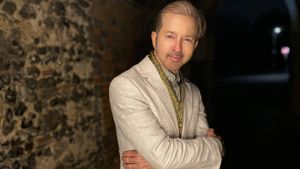Photographs By James Hosking.
When Ray Rudolph landed in San Francisco in 1976, he knew he'd found his moment. "There were a lot of gay people coming here from all parts of the country, and there were so many potentials at that time," he says. "I fell in love with it."
Ray was at the forefront of a massive transformation in American society. Now, 40 years later, he finds himself on the cutting edge of a new set of challenges. Like many who shared the moment with him, he is part of an aging segment of the LGBT community that finds it increasingly difficult to remain in the city it helped to build.
When he arrived, Ray scored an apartment off Polk Street, "the gay center of the city before the Castro," and took a job at PS Restaurant, where drag queens would arrive in limos and order the chateaubriand. He spent many afternoons hanging out with his friends at Harvey Milk's camera store and chatting about local issues and politics. Soon, he started campaigning for social change. "There was a lot of activism on the street," he says. "I was there for getting Harvey Milk elected, for the assassinations of Milk and [mayor George] Moscone. I helped organize the candlelight march on Market Street, and of course the White Night riots, when Dan White got off from murder charges on the so-called 'Twinkie defense.'"
With a neat mustache, a slim build, and lively blue eyes, Ray wears an updated version of the "Castro Clone" uniform that he adopted in the 1970s -- with the addition of sensible walking shoes. "We all wore jeans and boots and checked or flannel shirts back then, and I still hold on to that," he says with a smile. "But now I don't tuck in the shirt anymore, I leave the tails out."
For a while it seemed anything was possible. But in the late 1970s, according to Ray, life in San Francisco took an ominous turn. "Healthy friends were suddenly on canes and walkers. Then you didn't see them anymore. People disappeared overnight. They died."
 Ray Rudolph at his rent-stabilized apartment off Polk Street.
Ray Rudolph at his rent-stabilized apartment off Polk Street.
At 65, Ray is a long-term survivor of HIV. For many years his health was stable. But now, with a daily regimen of multiple medications, he suffers from asthma and Pneumocystis pneumonia, and his joints ache at times. He finds the city increasingly difficult to manage. His apartment is on a hill and requires climbing a long flight of steps just to reach the ground floor. "By the time I get from back from my marketing, I'm pooped," he says. "But at least I can still do it. Who knows what I'll be like in five or 10 years?"
"My generation created communities and identities and the gay press," he says. "Now we're trying to reinvent ourselves as seniors in a city that is not as welcoming or friendly. There's so much more traffic, density, construction than ever before, and many of us have been pushed to the side. I have a lot of friends struggling to navigate this city with walkers."
Yet moving to a more accessible apartment is out of the question. Ray pays under $1,000 per month for a rent-stabilized unit that would fetch $3,500 on the open market. And landlords seem increasingly eager to replace old-timers with younger, transient members of the technocratic elite.
"Landlords are evicting people for the most minor infractions, such as bringing a bicycle or a stroller through an accommodation hallway," says Ray. "They're doing this all over the city. Just two blocks from here, a 93-year-old woman was served with an eviction notice."
Rather than being wistful about the past, Ray focuses his energy on helping fellow LGBT seniors thrive in the present. Since 2007, he has volunteered at Openhouse, an organization offering a variety of social services and community-building activities for the city's LGBT seniors. Ray has volunteered with AIDS organizations; helped organize the Spring Fling and tribute to members of the Imperial Court; participated in programs on ageism, estate planning, and intergenerational connection; and spearheaded a neighborhood grassroots initiative to put plans in place for San Francisco's first LGBT-focused low-income housing development, called 55 Laguna.
"I'm really hoping I can get one of the units there," says Ray. "I don't know what I'll do if I can't."
There's a stereotypical view of LGBT seniors, and it usually involves a couple of gay men living high on the fruits of "double income, no children." But the statistics don't back it up. The poverty rate among LGBT people, including gay men, is significantly higher than that of the general population, and seniors face particularly daunting challenges.
One part of the problem for LGBT seniors, to paraphrase Faulkner, is that the past isn't really past. Mark Segal, a longtime LGBT activist and the founder of the John C. Anderson Apartments, a Philadelphia housing development for low-income LGBT seniors, frames the issue succinctly.
"With the first out generation, a lot of them lost their family support," he says. "On top of that, they weren't able to get a decent job with a 401(k). Because if you were out in those days, you not only could lose your job, but in many states in the country you couldn't practice in front of the bar -- you couldn't get your law license. You couldn't get your medical license. You couldn't work in law enforcement or the military. People don't remember how bad it was."
Having been denied the right to marry, same-sex couples have been denied myriad spousal benefits. LGBT seniors have also been disadvantaged by discriminatory laws pertaining to inheritance, estate taxes, and veterans' benefits. This lack of a level playing field has lasting effects on financial security, particularly in the retirement years.
Many of our elders have cultivated lives in urban centers, where the cost of real estate has recently risen dramatically. Perhaps nowhere is the impact more substantial than in San Francisco, the most expensive rental housing market in the country. In 2014, rents increased over 13 percent from the year before, contributing to the ongoing displacement of the region's poor and working class. Not surprisingly, the Bay Area poverty rate is rising too; as of 2013, it had edged up to a historic high at 11.3 percent. The city has little affordable housing, and the number of applicants has jumped.
Compounding the economic legacy of past discrimination is the very real problem of discrimination in the present. A 2011 report published by the National Senior Citizens Law Center (now known as Justice in Aging) showed that nearly 90 percent of LGBT seniors were afraid to be out in a senior care facility. Nearly half had faced discrimination in a care facility or knew someone who had.
"The scale of the problem is huge," says Michael Adams, CEO of Services and Advocacy for Gay, Lesbian, Bisexual, and Transgender Elders, or SAGE. "A substantial percentage of LGBT elders face housing discrimination. This is not speculation on our part."
To quantify the frequency and character of the discrimination, the Equal Rights Center, in collaboration with SAGE, embarked on a comprehensive study on the prevalence of housing discrimination. They used "matched pair" testing -- the same technique that has been used to quantify racial discrimination -- sending LGBT couples and their heterosexual counterparts to apply for housing in 10 states. The 2014 report of their findings, titled "Open Doors: An Investigation of Barriers to Senior Housing for Same-Sex Couples," documents the results.
In 96 of the 200 tests conducted, the tester with a same-sex spouse experienced at least one type of adverse treatment -- including differences in availability, pricing, amenities, and application requirements -- when compared with the heterosexual tester with an opposite-sex spouse. In some instances, housing providers made degrading or insulting remarks to prospective LGBT residents. The pattern of adverse treatment was clear.
As one researcher noted: "As [LGBT] old people enter assisted living situations, nursing homes, independent elderly housing or retirement communities, they are often presumed heterosexual and may feel the need to go back into the closet; often their long-term relationships are devalued and not recognized. Even if they have lived openly in the past, they may suddenly find themselves in situations where disclosing their sexual orientation or gender variance makes them vulnerable to discrimination or even abuse."
Segal points out that many residents at the John C. Anderson Apartments moved there after having experienced discrimination at other assisted-living facilities. "One lesbian couple came to us because at their other facility they would not let her partner of 30 years come visit," he says. "When she finally found out about our place, she applied and got in."
 Jasmine Gee Jasmine Gee is a trans senior and member of the Openhouse community. She lives in a single rented room in a family's home in the Outer Sunset, close to the Pacific Ocean.
Jasmine Gee Jasmine Gee is a trans senior and member of the Openhouse community. She lives in a single rented room in a family's home in the Outer Sunset, close to the Pacific Ocean.
Segal, who helped found the Gay Liberation Front after the Stonewall rebellion and is now publisher of Philadelphia Gay News, isn't the type of person to take this problem sitting down. He named his low-income LGBT senior housing project in Philadelphia after John C. Anderson for a reason. Anderson was a successful Philadelphia politician and attorney, but, more than that for Segal, he is a symbol of what might have been and could still be. "John C. Anderson was in the closet," notes Segal. "If he hadn't died of HIV he would have been the first African-American mayor." He sighs. "Ah, what a wonderful man he was."
"Ours is a place for our first out generation to live out their senior years in dignity," he continues. "We're not any kind of community if we don't take care of people when they're in danger, and if we don't take care of our old when they're in need."
Another successful project, Town Hall Apartments, has been established in an old police-department district station in the Boystown neighborhood of Chicago. Affiliated with an LGBT community center called Center on Halsted, in partnership with the antipoverty organization Heartland Alliance, the 79-unit building opened its doors in 2014.
"This neighborhood has been the gay community for the past 30 to 40 years," Center on Halsted spokesman Peter Johnson points out. "The new site was a point of contention, because for a time bar raids were a regular feature of the neighborhood. Now that we are actually inhabiting the police station that used to order those raids, we've come full circle. It's no longer a place of terror, and it mirrors the acceptance that this community has seen."
Other housing developments for low-income LGBT seniors -- in New York City, Los Angeles, Boston, and a handful of other locales -- are either completed or in the works. They join a handful of market-priced LGBT-focused housing developments for seniors, from The Resort on Carefree Boulevard, a lesbian community in Fort Myers, Fla., to Fountaingrove Lodge, in Santa Rosa, Calif., the nation's first LGBT continuing care facility, which also includes a memory care unit. While Fountaingrove's pricing, similar to that of other luxury senior housing developments, puts it out of reach for low-income seniors, many residents are retired schoolteachers, nurses, and police officers who benefited from the Bay Area housing boom.
Meanwhile, the work on 55 Laguna is fast nearing fruition. Fifteen years in the making, it is finally opening to a lottery in fall 2016.
"Everybody recognizes the need to age in a way that is authentic," says Seth Kilbourn, then executive director of Openhouse; he stepped down in May 2016 after eight years. "The three fundamental pillars of a healthy aging experience -- housing, social services, and community-building -- are important for all seniors. But for LGBT seniors in particular, who may have little biological-family support and are especially reliant on community networks, those pillars are especially important. Projects such as 55 Laguna are specifically designed to address that. When it opens, we will have Openhouse on the ground floor to address the needs of residents as well as others in the wider community."
All low-income housing in San Francisco is assigned by lottery, and 55 Laguna's 39 units (an additional 80 units next door are slated to open in fall 2018) are no different. While the housing nondiscrimination laws that we have fought so hard to secure require that the lottery is open to everyone regardless of sexual orientation or gender identity, 55 Laguna's marketing materials increase the likelihood that applicants will self-select.
"All of our research shows that what LGBT seniors are looking for is to live in a welcoming environment," says Kilbourn. "55 Laguna will never be exclusively LGBT, but that's not what they want. They want to live among people who are LGBT themselves, as well as others who value inclusion, diversity, and understanding. And that's what all our marketing material and work is designed to produce."
Currently, federal law does not expressly prohibit housing discrimination based on sexual orientation or gender identity in the private housing market. In 2012, however, the U.S. Department of Housing and Urban Development (HUD) promulgated a rule prohibiting discrimination based on sexual orientation or gender identity in any HUD-assisted housing.
At the time of this writing, 22 states, the District of Columbia, and a growing number of cities and counties prohibit housing discrimination based on sexual orientation and/or gender identity. Where protections do exist, there is often a lack of organizations and resources to monitor them.
The piecemeal efforts to secure housing rights for LGBT seniors, however, face a new and daunting counteroffensive. The loudest objections are coming from right-wing faith-based organizations. This presents a formidable challenge, because faith-based organizations are powerful players in the affordable-senior-housing market. Nearly half of all sponsors of HUD-developed housing for the elderly are faith-based.
The crux of the counteroffensive is to relabel discrimination against LGBT people as a religious "right," and then to seek legal protection for this "right" to discriminate. A flagship of the strategy is a new bill titled the First Amendment Defense Act, a version of the Marriage and Religious Freedom Act introduced in 2013. The basic point of the bill is to allow federal government officials, including social-service providers, to discriminate against people who offend their religious sensibilities. FADA explicitly applies to government grantees and contractors, which are private organizations.
FADA presents itself as a "religious liberty" bill, but in fact it specifically protects only those people whose religion avowedly leads them to believe that marriage should be between one man and one woman, and that sexual relations outside of heterosexual marriage are immoral. If your religion or conscience tells you otherwise, there is no liberty in the bill for you.
Under FADA, workers responsible for processing benefit claims made by same-sex couples -- or unmarried couples of any variety -- could refuse to do so with impunity. Employees at a homeless shelter that receives federal grants could likewise refuse to serve same-sex couples, unmarried couples, or single mothers. Hospitals could refuse to allow visits from LGBT partners or spouses, and landlords could refuse to rent to them. Businesses could violate family medical leave law and refuse to allow an LGBT employee to care for his or her sick spouse.
FADA has been endorsed by Ted Cruz, Marco Rubio, and other prominent conservatives, as well as the Republican National Committee. It is a key goal of socially conservative groups. And FADA is just one of the "religious freedom" bills in the pipeline. This year alone, 110 "religious freedom" bills have been introduced in 31 states. Versions have passed in Indiana, North Carolina, and Mississippi.
"These religious-freedom initiatives are concerning," says SAGE's Michael Adams. "They make it sound like the religious-freedom laws are about some guy who doesn't want to be forced to bake a wedding cake. This isn't about that. Affordable housing for senior LGBT citizens is under threat."
While the legal and political struggles play out overhead, in Philadelphia, as in San Francisco, Chicago, and elsewhere, communities get on with the business of making better lives. At the John C. Anderson Apartments, lush landscaping abounds, courtesy of green-thumbed residents. Only low-income seniors qualify for entry, but the clean, modern finishes and spacious interiors give the building the feel of a top-of-the-scale condo. A spacious interior courtyard is replete with romantic nooks, benches, a barbecue, and a bubbling fountain.
"We have an incredible group of people living here," says Mark Segal. "A rainbow of every kind of life you can imagine in the community. Our residents are extremely special; they get involved in the community, from civic organizations to town watches to bike organizations. They open up the courtyard and the community and host benefits for various nonprofits. They are wonderful, caring individuals."
He pauses. "I think they should run a soap opera."
This story was supported by the Economic Hardship Reporting Project, a journalism nonprofit.
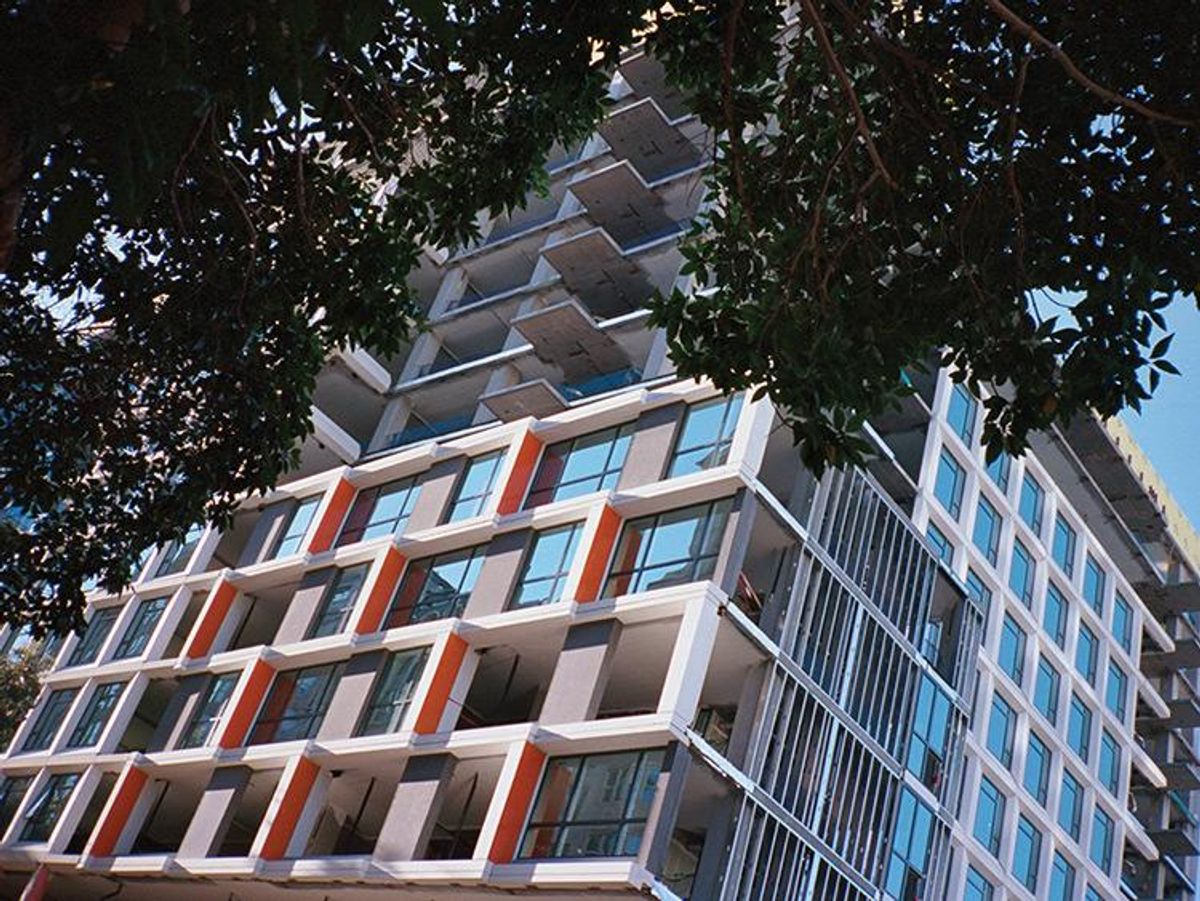














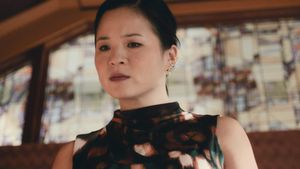














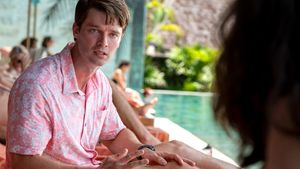
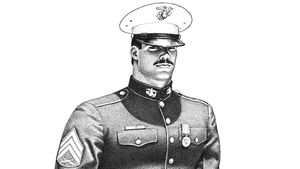
 Ray Rudolph at his rent-stabilized apartment off Polk Street.
Ray Rudolph at his rent-stabilized apartment off Polk Street. Jasmine Gee Jasmine Gee is a trans senior and member of the Openhouse community. She lives in a single rented room in a family's home in the Outer Sunset, close to the Pacific Ocean.
Jasmine Gee Jasmine Gee is a trans senior and member of the Openhouse community. She lives in a single rented room in a family's home in the Outer Sunset, close to the Pacific Ocean.












